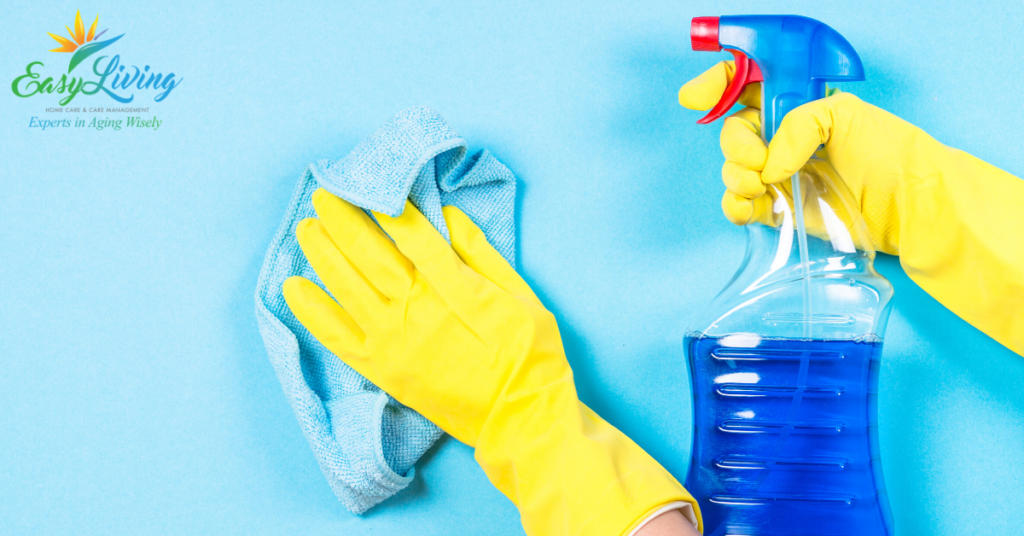What’s the difference between cleaning and disinfecting?
Cleaning removes germs, dirt, and impurities from surfaces. It lessens the risk of spreading infection by reducing the number of germs, but it does not kill germs. Disinfecting involves using chemicals to kill germs.
What are the best practices for cleaning and disinfecting for COVID-19?
The best bet is to first clean a surface and then disinfect it. For people isolating at home, the CDC recommends cleaning and disinfecting high-touch areas daily. This includes: counters, tables, hard-backed chairs, doorknobs, handles, light switches, TV remotes, cell phones, desks, toilets, and sinks. EasyLiving caregivers can help with keeping your home cleaned and disinfected.
Contact us about EasyLiving home hygiene and household help: Send an email or call 727-447-5845 or 813-333-5020.
How should I disinfect surfaces in my home?
First, start by cleaning surfaces (scrubbing with soap/detergent and water). Wear gloves while cleaning and disinfecting and remove/dispose of them properly. In your own home or if you don’t have gloves, wash your hands before and after while being sure not to touch your face.
Then, disinfect with a diluted bleach solution, an alcohol solution with at least 70% alcohol, or an approved disinfectant (typically, look for something guaranteed to kill 99.9% of germs).
Making a diluted bleach solution:
Mix four teaspoons of bleach to one quart of water.
Precautions:
- Check the expiration date as expired bleach may not be effective.
- Be sure bleach will not harm the surfaces you are disinfecting.
- Never mix bleach with other household cleaners, ammonia or vinegar as it can create a hazardous gas.
- Only make as much solution as you need for that day, as it becomes less effective after 24 hours. Label bleach solution and keep it away from children, pets, and adults with dementia.
- To discard, dilute with more water and pour down a sink drain.
Get “COVID-19 Safety Tips for Cleaning and Disinfecting” (this is great for posting in your home and sharing with loved ones):
More FAQs about COVID-19 Cleaning and Disinfecting
Can coronavirus droplets survive on clothing?
Scientists have found the virus is most likely to survive on hard surfaces, like plastic and steel. However, it is still a good idea to remove your shoes and remove/clean work clothing if you work in healthcare or are concerned about exposure.
What are the best practices for doing laundry?
Wash your own clothes using the warmest water temperature possible. Clean and disinfect clothes hampers (if used), or use a disposable liner. When doing laundry for someone with COVID-19, follow precautions including wearing disposable gloves. Do not shake laundry. Be careful not to touch your face, remove gloves properly, and wash your hands.
Does it matter what type of soap I use to wash my hands?
No, it does not matter and since this is a virus, it does not need to be antibacterial. The important thing is to wash hands thoroughly for at least 20 seconds. The combination of the soap and friction help remove the virus.
Should I be disinfecting my cell phone?
If possible, try not to use your cell phone around others, particularly if caring for sick patients. It is recommended to clean your cell phone often with a disinfecting wipe (something with 70% or more alcohol content). Clean the back and sides well, too, but avoid the ports. Don’t use a wipe with bleach as it can ruin your phone. You can also use a spray and then wipe it off. Read more here and/or check if your phone manufacturer has recommendations. Consider putting a screen protector on to protect the screen from cleaners, scratches, etc.
What about disinfecting my packages and groceries?
There is no evidence that food or food packaging play a significant role in spreading the virus in the United States. It may be possible that a person can get COVID-19 by touching a surface or object, like packaging, that has the virus on it and then touching their own mouth, nose, or possibly their eyes. However, this is not thought to be the main way the virus spreads.
Though the risk is likely very low, at-risk persons may want to take extra precautions, especially given the unknown and possibly changing nature of the virus. And, you should always wash your hands after handling any deliveries or packaging.







